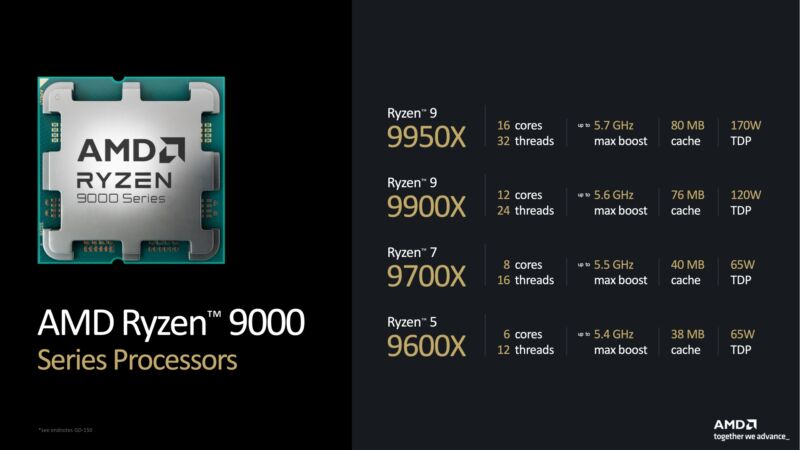still processing —
Ryzen 9000 will also have more overclocking headroom, for those interested.

Enlarge / AMD’s Ryzen 9000 launch lineup.
AMD
AMD has released more information about its next-generation Ryzen 9000 processors and their underlying Zen 5 CPU architecture this week ahead of their launch at the end of July. The company reiterated some of the high-level performance claims it made last month—low- to mid-double-digit performance increases over Zen 4 in both single- and multi-threaded tasks. But AMD also bragged about the chips’ power efficiency compared to Ryzen 7000, pointing out that they would reduce power usage despite increasing performance.
Prioritizing power efficiency
AMD said that it has lowered the default power limits for three of the four Ryzen 9000 processors—the Ryzen 5 9600X, the Ryzen 7 9700X, and the Ryzen 9 7900X—compared to the Ryzen 7000 versions of those same chips. Despite the lower default power limit, all three of those chips still boast double-digit performance improvements over their predecessors. AMD also says that Ryzen 9000 CPU temperatures have been reduced by up to 7º Celsius compared to Ryzen 7000 chips at the same settings.
-
Ryzen 9000’s low-double-digit performance gains are coming despite the fact that the company has lowered most of its chips’ default TDPs. These TDP settings determine how much power one of AMD’s CPUs can use (though not necessarily how much they will use).
AMD
-
Because the TDPs have been lowered, AMD claims that Ryzen 9000 chips will have a bit more overclocking headroom than Ryzen 7000.
AMD
It’s worth noting that we generally tested the original Ryzen 7000 CPUs at multiple power levels, and for most chips—most notably the 7600X and 7700X—we found that the increased TDP levels didn’t help performance all that much in the first place. The TDP lowering in the Ryzen 9000 may be enabled partly by architectural improvements or a newer manufacturing process, but AMD already had some headroom to lower those power usage numbers without affecting performance too much. TDP is also best considered as a power limit rather than the actual amount of power that a CPU will use for any given workload, even when fully maxed out.
Still, we appreciate AMD’s focus on power efficiency for the Ryzen 9000 series, especially because Intel’s high-end 13900K and 14900K have been plagued by crashes that seem to be related to high power use and improper motherboard configurations. Intel has yet to release a definitive statement about what the issue is, but it’s plausible (maybe even likely!) that it’s a side effect of these chips being pushed to their thermal and electrical limits.
Ryzen 9000 CPUs can still be pushed further by users who want to raise those power limits and try overclocking—AMD points out that the chips all have more headroom for Precision Boost Overdrive automated overclocking, precisely because the default power limits leave a little more performance on the table. But as long as the chips still perform well at their default settings, people who just want to build a computer without doing a ton of tinkering will be better served by chips that run cooler and use less power.
More time on the clock for socket AM5
-
AMD has committed to supporting the AM5 socket until “2027+,” two more years than the “2025+” it promised back in late 2022.
AMD
-
Ryzen 9000 will launch alongside several marginally updated chipsets, though existing AM5 boards will be able to use these chips after a BIOS update.
AMD
Another small but noteworthy change buried in AMD’s slide decks, and good news for anyone who has already invested in a Socket AM5 motherboard or has plans to do so in the near future: AMD has officially extended the socket’s guaranteed support timeline to at least 2027 and is leaving the door open to support past that point. That’s a two-year extension from the “2025+” timeline that the company laid out in late 2022.
Of course, “support” could mean a lot of different things. AMD is still officially supporting the AM4 socket with new CPU releases and continues to lean on AM4 as a budget platform as socket AM5 costs have remained stubbornly high. But these “new” releases have all been repackagings of various iterations of the late-2020-era Ryzen 5000 CPUs, rather than truly new products. Still, AMD’s formal commitment to socket AM5’s longevity makes it a bit easier to recommend for people who upgrade their CPUs regularly.
Ryzen 9000 chips will be able to pop into any current AM5 motherboard after a BIOS update. The company is also announcing a range of 800-series chipsets for new motherboards, though these generally only come with minor improvements compared to the 600-series chipsets they replace. The X870E and X870 are guaranteed to have USB 4 ports, and the X870 supports PCIe 5.0 speeds for the GPU slot where the X670 only supported PCIe 4.0 speeds for the GPU slot. The lower-end B850 chipset still supports PCIe 5.0 speeds for SSDs and PCIe 4.0 speeds for GPUs, while an even lower-end B840 chipset is restricted to PCIe 3.0 speeds for everything. The B840 also won’t support CPU overclocking, though it can still overclock RAM.
Listing image by AMD